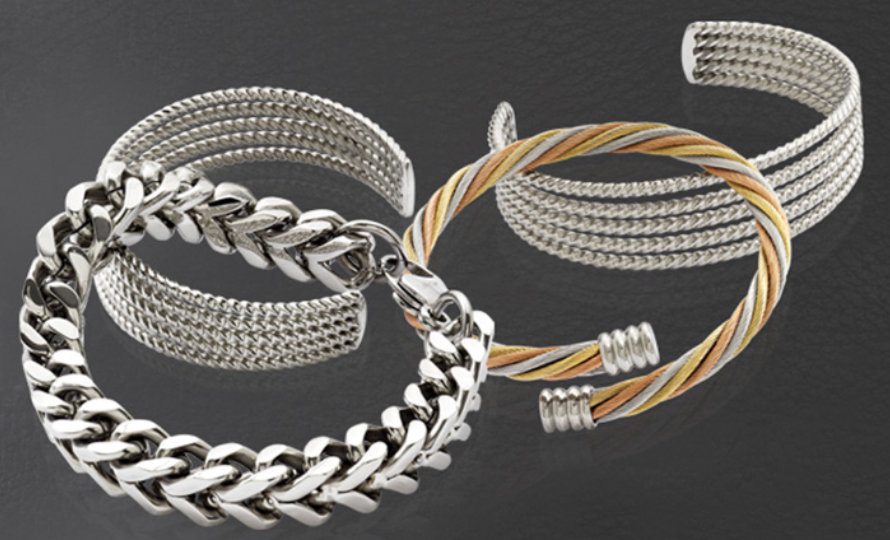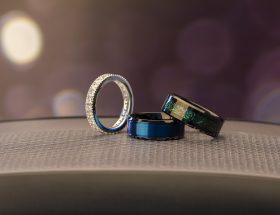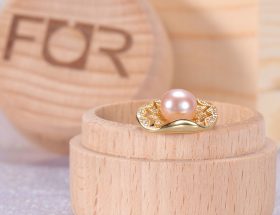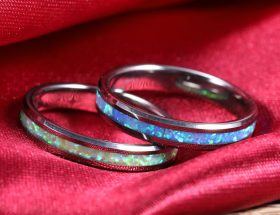Introduction: The Allure of Stainless Steel Jewelry
Amidst the myriad of choices in the realm of adornments, stainless steel trinkets have ascended the echelons of preference. Their allure? Not merely their economical appeal or their polished visage, but their tenacious resistance to the ravages of oxidation and degradation. Yet, akin to all treasures of value, they beckon meticulous guardianship to preserve their radiant sheen and undiminished splendor.
The Basics of Stainless Steel
Stainless steel is an alloy made up of iron, carbon, and chromium. The addition of chromium gives it its anti-corrosive properties.
Composition and Properties: Typically, stainless steel used in jewelry contains about 10-30% chromium, making it resistant to tarnishing and rust. It’s also hypoallergenic, making it suitable for those with sensitive skin.
Why It’s Popular for Jewelry: Beyond its durability, stainless steel has a modern, sleek look. Its neutral color complements various gemstones and other metals, making it versatile for different jewelry designs.

Why Cleaning is Essential
Even though stainless steel is resistant to tarnish, it can still get dirty or smudged from daily wear.
Preventing Tarnish and Discoloration: Oils from the skin, lotions, and everyday dirt can accumulate on the jewelry, leading to a dull appearance. Regular cleaning ensures it remains bright and shiny.
Maintaining its Shine and Luster: Just like any other piece of jewelry, stainless steel can lose its shine over time. Cleaning it regularly ensures it retains its original sparkle.
Everyday Cleaning Methods
For daily or weekly cleaning, you don’t need any fancy products. Simple household items can do the trick.
Soap and Water Technique: A gentle dish soap mixed with warm water can effectively clean your jewelry. Use a soft cloth or a soft-bristled toothbrush to gently scrub the jewelry, then rinse and pat dry.
Using Baking Soda: For tougher stains, make a paste with baking soda and water. Apply the paste to the jewelry, gently scrub, rinse, and dry.
Deep Cleaning Techniques
Occasionally, your jewelry might need a deeper clean, especially if it’s exposed to harsher elements.
Vinegar Solution: Mix equal parts of white vinegar and water. Soak your jewelry for 20-30 minutes, then scrub, rinse, and dry.
Lemon Juice and Olive Oil Method: Mix 1/2 cup of lemon juice with 1/2 cup of olive oil. Dip a cloth into the solution, wring it out, and polish your jewelry.

Commercial Cleaners
While natural methods are effective, sometimes you might need something stronger.
When to Use Them: If your jewelry has stubborn stains or has lost its shine, a commercial cleaner can help restore it.
Precautions and Recommendations: Always read the label and ensure the cleaner is safe for stainless steel. Avoid those with harsh chemicals that might damage your jewelry.
Ultrasonic Cleaners
These devices use ultrasonic waves to clean jewelry. They can be effective but should be used with caution.
What Are They? Ultrasonic cleaners use sound waves to create bubbles that dislodge dirt and grime from jewelry.
Pros and Cons: While they can provide a deep clean, they might not be suitable for jewelry with gemstones or intricate designs, as the vibrations can dislodge stones or damage delicate parts.
Preventing Scratches
Stainless steel is durable, but it’s not immune to scratches.
Proper Storage: Store your jewelry in a soft pouch or a jewelry box with individual compartments.
Avoiding Abrasive Surfaces: Be mindful when wearing your jewelry. Avoid activities that might expose it to rough surfaces.

Avoiding Common Mistakes
Proper care ensures the longevity of your stainless steel jewelry.
Things to Avoid: Avoid exposing your jewelry to chlorine, saltwater, or harsh chemicals. These can damage the protective layer on stainless steel.
Ensuring Longevity: By following proper cleaning and storage methods, you can ensure your stainless steel jewelry lasts for years.
Drying and Polishing
After cleaning, it’s essential to dry and polish your jewelry to bring out its shine.
Importance of Thorough Drying: Water spots can tarnish stainless steel. Ensure your jewelry is completely dry before storing it.
Polishing Techniques: Use a soft, lint-free cloth to polish your jewelry. You can also use a commercial stainless steel polish for added shine.

Benefits of Regular Cleaning
Regular cleaning not only keeps your jewelry looking new but also extends its life.
Enhancing Durability: Dirt and grime can be abrasive. Regular cleaning prevents potential damage.
Aesthetic Appeal: Clean jewelry always looks better. It shines brighter and looks more valuable.
Professional Cleaning
Sometimes, it’s best to leave it to the professionals.
When to Consider: If your jewelry has deep-set stains or if you’re unsure about cleaning it yourself, consider professional cleaning.
What to Expect: Professionals have specialized tools and solutions to clean and restore your jewelry.
DIY vs. Professional Cleaning
Both methods have their pros and cons.
Weighing the Pros and Cons: DIY methods are cost-effective and can be done at home. Professional cleaning, while more expensive, ensures a thorough clean.
Making an Informed Decision: Depending on the condition of your jewelry and your comfort level, choose the method that’s best for you.
Safety Precautions
When cleaning, it’s essential to be mindful of the jewelry’s components.
Protecting Gemstones and Inlays: Some cleaning methods might not be suitable for gemstones. Always check before cleaning.
Avoiding Chemical Reactions: Ensure the cleaning solutions you use are safe for stainless steel to prevent adverse reactions.

Storing Stainless Steel Jewelry
Proper storage is just as crucial as cleaning.
Best Practices: Store your jewelry in a cool, dry place. Avoid direct sunlight and moisture.
Avoiding Moisture and Humidity: These can tarnish stainless steel. Use silica gel packets in your jewelry box to absorb excess moisture.
FAQs
Why is my stainless steel jewelry tarnishing?
It’s generally safe to wear stainless steel jewelry in the shower. However, it’s essential to dry it thoroughly afterward. Prolonged exposure to moisture can lead to water spots or potential tarnishing. If your jewelry has gemstones or other elements, it’s best to remove it before showering.
Can I wear my stainless steel jewelry in the shower?
Ordinarily, donning stainless steel adornments whilst indulging in a shower poses minimal peril. Yet, post-aqueous engagement, meticulous desiccation becomes paramount. Extended dalliance with dampness might culminate in unsightly aqueous imprints or potential discoloration. Should your trinket be embellished with gemstones or other intricate facets, prudence dictates its removal prior to aquatic immersion.
How often should I clean my stainless steel jewelry?
For everyday wear items, it’s a good idea to clean them once a week to remove dirt, oil, and any residues. If you wear your jewelry occasionally, cleaning it once a month or before storing it should suffice.
Is toothpaste a good cleaner for stainless steel jewelry?
Toothpaste, in its unconventional utility, emerges as a makeshift purifier for stainless steel ornaments. Imperative it becomes, however, to opt for a variant devoid of gel and abrasive elements. A diminutive dollop upon a plush fabric, followed by a gentle caress over the ornament, a subsequent rinse under the tap, and a thorough drying session are the steps to ensue. Whilst toothpaste may prove its mettle against minor blemishes, its enlistment as a habitual cleaning agent is not something one would advocate.
Will stainless steel jewelry turn my skin green?
Contrary to some misconceptions, stainless steel ornaments won’t impart a verdant hue to your dermis. Such emerald tinges, occasionally observed by wearers of various trinkets, predominantly arise from interactions between epidermal secretions and the presence of copper or nickel elements within the adornments. Superior-grade stainless steel trinkets are crafted to be hypoallergenic, thus eliminating the likelihood of such chromatic aberrations.
Can I use vinegar to clean stainless steel jewelry?
Yes, vinegar can be used to clean stainless steel jewelry. Mix equal parts of white vinegar and water, soak the jewelry for 20-30 minutes, then scrub gently with a soft cloth or brush. Rinse thoroughly and dry. Vinegar is a mild acid that can help remove tarnish and restore shine.
How can I restore the shine to my stainless steel jewelry?
To rejuvenate the radiant gleam of stainless steel trinkets, one might consider employing a specialized jewelry buffing fabric or perhaps an artisanal stainless steel luminance enhancer. By adhering to a regimen of meticulous cleansing coupled with sporadic burnishing, one can efficaciously uphold the trinket’s brilliance whilst warding off any unsightly tarnish.









